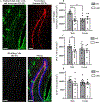Loss of α7 nicotinic acetylcholine receptors in GABAergic neurons causes sex-dependent decreases in radial glia-like cell quantity and impairments in cognitive and social behavior
- PMID: 33398432
- PMCID: PMC8121181
- DOI: 10.1007/s00429-020-02179-3
Loss of α7 nicotinic acetylcholine receptors in GABAergic neurons causes sex-dependent decreases in radial glia-like cell quantity and impairments in cognitive and social behavior
Abstract
The dentate gyrus (DG) is a unique brain structure in that neurons can be generated postnatally and integrated within existing circuitry throughout life. The maturation process of these newly generated neurons (granule cells) is modulated by nicotinic acetylcholine receptors (nAChRs) through a variety of mechanisms such as neural stem pool proliferation, cell survival, signal modulation, and dendritic integration. Disrupted nAChR signaling has been implicated in neuropsychiatric and neurodegenerative disorders, potentially via alterations in DG neurogenesis. GABAergic interneurons are known to express nAChRs, predominantly the α7 subtype, and have been shown to shape development, integration, and circuit reorganization of DG granule cells. Therefore, we examined histological and behavioral effects of knocking out α7 nAChRs in GABAergic neurons. Deletion of α7 nAChRs resulted in a reduction of radial glia-like cells within the subgranular zone of the DG and a concomitant trend towards decreased immature neurons, specifically in male mice, as well as sex-dependent changes in several behaviors, including social recognition and spatial learning. Overall, these findings suggest α7 nAChRs expressed in GABAergic neurons play an important role in regulating the adult neural stem cell pool and behavior in a sex-dependent manner. This provides important insight into the mechanisms by which cholinergic dysfunction contributes to the cognitive and behavioral changes associated with neurodevelopmental and neurodegenerative disorders.
Keywords: DCX; GFAP; Memory; Neurogenesis; Progenitor; Stem cell.
Figures






Similar articles
-
Differential signalling induced by α7 nicotinic acetylcholine receptors in hippocampal dentate gyrus in vitro and in vivo.J Physiol. 2021 Oct;599(20):4687-4704. doi: 10.1113/JP280505. Epub 2021 Sep 28. J Physiol. 2021. PMID: 34487349 Free PMC article.
-
Functional alpha7 nicotinic receptors are expressed on immature granule cells of the postnatal dentate gyrus.Brain Res. 2015 Mar 19;1601:15-30. doi: 10.1016/j.brainres.2014.12.041. Epub 2014 Dec 29. Brain Res. 2015. PMID: 25553616 Free PMC article.
-
Endogenous signaling through alpha7-containing nicotinic receptors promotes maturation and integration of adult-born neurons in the hippocampus.J Neurosci. 2010 Jun 30;30(26):8734-44. doi: 10.1523/JNEUROSCI.0931-10.2010. J Neurosci. 2010. PMID: 20592195 Free PMC article.
-
Neural mechanisms underlying GABAergic regulation of adult hippocampal neurogenesis.Cell Tissue Res. 2018 Jan;371(1):33-46. doi: 10.1007/s00441-017-2668-y. Epub 2017 Sep 25. Cell Tissue Res. 2018. PMID: 28948349 Free PMC article. Review.
-
[Dual Roles of α7 Nicotinic Acetylcholine Receptors Expressed in Immune Cells in T Cell Differentiation -α7 nAChRs Exert Different Actions between Antigen-presenting Cells and CD4+ T Cells].Yakugaku Zasshi. 2020;140(12):1421-1425. doi: 10.1248/yakushi.20-00151. Yakugaku Zasshi. 2020. PMID: 33268683 Review. Japanese.
Cited by
-
Loss of GABA co-transmission from cholinergic neurons impairs behaviors related to hippocampal, striatal, and medial prefrontal cortex functions.Front Behav Neurosci. 2022 Nov 24;16:1067409. doi: 10.3389/fnbeh.2022.1067409. eCollection 2022. Front Behav Neurosci. 2022. PMID: 36505727 Free PMC article.
-
α7 nicotinic acetylcholine receptors in the hippocampal circuit: taming complexity.Trends Neurosci. 2022 Feb;45(2):145-157. doi: 10.1016/j.tins.2021.11.006. Epub 2021 Dec 13. Trends Neurosci. 2022. PMID: 34916082 Free PMC article. Review.
-
Targeting Alpha7 Nicotinic Acetylcholine Receptors in Lung Cancer: Insights, Challenges, and Therapeutic Strategies.ACS Pharmacol Transl Sci. 2023 Dec 21;7(1):28-41. doi: 10.1021/acsptsci.3c00138. eCollection 2024 Jan 12. ACS Pharmacol Transl Sci. 2023. PMID: 38230275 Free PMC article. Review.
-
Genetic deletion of α7 nAChRs reduces hippocampal granule and pyramidal cell number in both sexes but impairs pattern separation in males only.Front Neurosci. 2023 Sep 7;17:1244118. doi: 10.3389/fnins.2023.1244118. eCollection 2023. Front Neurosci. 2023. PMID: 37746145 Free PMC article.
-
In the pursuit of new social neurons. Neurogenesis and social behavior in mice: A systematic review.Front Cell Dev Biol. 2022 Nov 4;10:1011657. doi: 10.3389/fcell.2022.1011657. eCollection 2022. Front Cell Dev Biol. 2022. PMID: 36407114 Free PMC article. Review.
References
MeSH terms
Substances
Grants and funding
LinkOut - more resources
Full Text Sources
Other Literature Sources
Molecular Biology Databases
Miscellaneous

